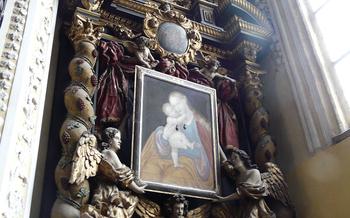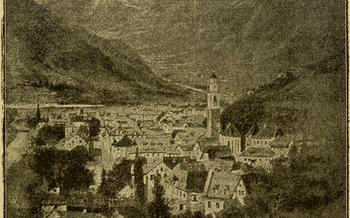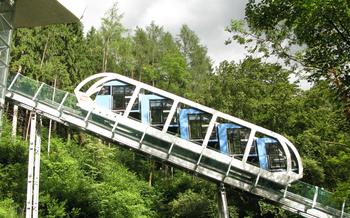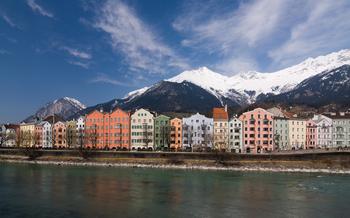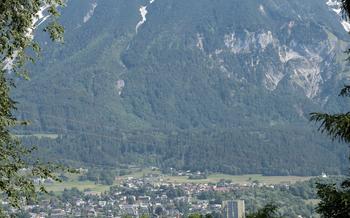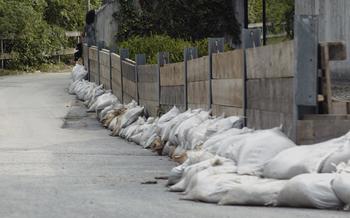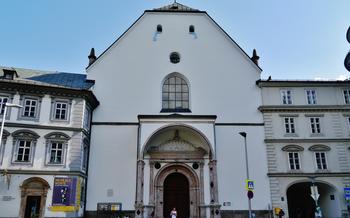
Innsbruck's Golden Roof
- The Golden Roof in Innsbruck
- Architectural Features of the Golden Roof
- The Golden Roof's Symbolic Importance
- Visiting the Golden Roof
- Exploring the Innsbruck Old Town
- Hofburg Innsbruck - A Glimpse into Imperial Grandeur
- The Hofkirche
- Nordkette Mountains: A Majestic Alpine Embrace
- Swarovski Crystal Worlds: A Dazzling Realm of Crystal Art
- Bergisel Ski Jump: A Marvel of Architecture and Engineering
- Tratzberg Castle: A Majestic Medieval Gem
- Hall in Tirol: A Hidden Gem with Mining History
- Insider Tip: Unique Experiences
The Golden Roof in Innsbruck
In the heart of Innsbruck's Old Town, nestled amidst a picturesque maze of cobblestone streets and historic buildings, lies a remarkable architectural gem - the Golden Roof. This iconic landmark, known locally as the Goldenes Dachl, is a symbol of the city's rich history and cultural heritage. The Golden Roof is a magnificent example of late Gothic architecture, adorned with over 2,657 fire-gilded copper tiles that shimmer and gleam in the sunlight, captivating visitors with its resplendent beauty.
Architectural Features of the Golden Roof
The Golden Roof stands as a testament to the exquisite craftsmanship and artistic vision prevalent during the Gothic period. Its ornate golden tiles, glistening in the sunlight, are the most striking feature of this iconic landmark. These tiles, numbering approximately 2,657, were painstakingly crafted from fire-gilded copper and arranged in a shingle-like pattern to create a dazzling effect.
Beneath the shimmering golden tiles, the roof's structural elements reveal the intricate Gothic style. The roofline, with its graceful curves and pointed arches, is supported by a series of slender columns and delicate ribs. The interplay of these architectural elements lends the Golden Roof an air of lightness and elegance, belying its historical significance.
The balcony, a prominent feature of the Golden Roof, projects from the central section of the building and is supported by ornate corbels. It is adorned with a series of intricate arches, each decorated with delicate tracery and finials. The balcony, once used by the Tyrolean rulers to address their subjects, adds to the regal grandeur of this architectural masterpiece.
The Golden Roof is further embellished with a wealth of symbolic decorations. Gargoyles, with their menacing expressions and grotesque features, are positioned at the corners of the roof, serving as guardians against evil spirits. Additionally, the roof features a series of intricate carvings depicting various figures and scenes, each holding its own symbolic meaning and adding to the overall narrative of this iconic landmark.
The Golden Roof's Symbolic Importance
The Golden Roof holds immense symbolic significance, representing the power and prestige of the Habsburg dynasty, who ruled over Tyrol for centuries. The intricate golden tiles and ornate decorations serve as a visual representation of the wealth and opulence of the Habsburgs, highlighting their status as one of the most powerful ruling families in Europe.
Moreover, the Golden Roof is deeply connected to the Tyrolean identity, embodying the region's rich history and cultural heritage. The Tyroleans take great pride in this iconic landmark, which has become an enduring symbol of their unique identity and traditions. In addition to its political and cultural significance, the Golden Roof also holds historical importance, serving as a reminder of the pivotal events that have shaped Innsbruck's development. It has witnessed countless historical moments, from royal celebrations and diplomatic gatherings to periods of conflict and upheaval.
Throughout the centuries, the Golden Roof has remained a beloved symbol, deeply cherished by the people of Innsbruck and Tyrol. Its cultural and historical significance continues to attract visitors from around the world, who come to admire its beauty and learn about its rich history.
Visiting the Golden Roof
The Golden Roof is conveniently located in Innsbruck's Old Town, a picturesque neighborhood with cobblestone streets, historic buildings, and charming shops. The Old Town is easily accessible by foot, bicycle, or public transportation. Once you arrive in the Old Town, the Golden Roof is hard to miss—its golden tiles and ornate balcony make it a standout feature of the cityscape.
To enhance your visit, guided tours and audio guides are available to provide insights into the history, symbolism, and significance of the Golden Roof. These tours offer a deeper understanding of the building's past and its connection to Innsbruck's rich history.
Accessibility for disabled visitors is a priority at the Golden Roof. The building is equipped with ramps and elevators, ensuring that everyone can enjoy this architectural masterpiece. Additionally, the Golden Roof offers guided tours in sign language upon request, allowing visitors with hearing impairments to fully appreciate this iconic landmark.
The Golden Roof is open to the public daily, with varying hours depending on the season. Admission fees are reasonable, and there are discounts available for students, seniors, and groups. It's advisable to check the official website or contact the Innsbruck Tourism Board for the most up-to-date information on opening hours and admission fees.
Exploring the Innsbruck Old Town
The Golden Roof's location in Innsbruck's Old Town makes it a great starting point for exploring the city's rich history and vibrant culture. Take a leisurely stroll through the narrow cobblestone streets, lined with colorful buildings, charming cafes, and inviting shops. Discover hidden courtyards, historic landmarks, and picturesque squares that tell the story of Innsbruck's past.
Admire the stunning architecture of the Old Town Hall, with its Gothic facade and intricate carvings. Visit the City Tower, a remnant of Innsbruck's medieval fortifications, and climb to its viewing platform for breathtaking panoramic views. Explore the Hofburg, the former imperial palace, and immerse yourself in the grandeur of its opulent halls and museums.
Innsbruck's Old Town is a shopper's paradise, with a variety of boutiques, art galleries, and souvenir shops offering unique treasures. Indulge in delicious Tyrolean cuisine at one of the many traditional restaurants, or savor a cup of coffee and a slice of cake at a cozy café. Take advantage of the vibrant nightlife scene, with bars, clubs, and live music venues catering to every taste.
Throughout the year, Innsbruck's Old Town hosts a variety of cultural events and festivals that showcase the city's rich heritage. Attend a traditional folk music concert, experience the magic of a Christmas market, or join the lively celebrations during Fasnacht, Innsbruck's version of Mardi Gras.
With its captivating blend of history, charm, and vibrant atmosphere, Innsbruck's Old Town is an unmissable destination for visitors seeking a truly authentic Tyrolean experience.
Hofburg Innsbruck - A Glimpse into Imperial Grandeur
Innsbruck's Hofburg is a testament to the city's rich history and imperial heritage. This former imperial palace stands as a majestic symbol of Habsburg rule and offers a glimpse into the lives of the Tyrolean nobility. With its blend of architectural styles and historical periods, Hofburg Innsbruck is a captivating attraction that transports visitors back in time.
Originally built in the 15th century as a residence for the Tyrolean counts, the Hofburg underwent significant expansions and renovations over the centuries. It served as the seat of government for the Habsburg rulers of Tyrol and witnessed numerous historical events. The palace complex comprises several wings and courtyards, each reflecting different architectural influences, from Gothic to Renaissance and Baroque.
Today, Hofburg Innsbruck houses several museums and cultural institutions, allowing visitors to explore its history and significance. The Imperial Apartments offer a glimpse into the lavish lifestyle of the Habsburgs, with their opulent furnishings and intricate decorations. The Hofkirche, or Court Church, is a stunning example of Gothic architecture and is home to the elaborate tomb of Emperor Maximilian I, adorned with intricate sculptures and stained glass windows.
Visitors to Hofburg Innsbruck can wander through its courtyards, admire the architectural details, and soak up the atmosphere of this historic palace. Guided tours provide insights into the history and stories behind the palace, making it a must-visit destination for anyone interested in Tyrolean and Austrian history.
The Hofkirche
The Hofkirche, also known as the Imperial Church, is a stunning example of Gothic architecture and one of the most significant landmarks in Innsbruck. Built in the 16th century by Emperor Maximilian I, this magnificent church is a testament to his power and devotion.
The church is adorned with intricate sculptures, elaborate stained glass windows, and a wealth of artistic treasures. The highlight is the tomb of Emperor Maximilian I, an impressive monument featuring 28 bronze statues of his ancestors and contemporaries. The life-size figures, each with its own unique character, are a testament to the emperor's legacy and the artistic prowess of the Renaissance period.
The Hofkirche is not just a historical monument but also a vibrant spiritual center. Regular church services and concerts are held within its sacred walls, creating a harmonious blend of history, art, and devotion.
Nordkette Mountains: A Majestic Alpine Embrace
Nestled in the heart of Tyrol, the Nordkette Mountains rise majestically above Innsbruck, beckoning adventurers and nature enthusiasts with their breathtaking beauty. These towering peaks, part of the Karwendel range, offer a feast for the eyes, with panoramic vistas that stretch as far as the eye can see.
The Nordkette Cable Car, a marvel of engineering, whisks visitors to the summit in a matter of minutes, revealing a breathtaking world of pristine alpine landscapes. From the top, a network of hiking trails, mountain biking routes, and climbing opportunities await, inviting you to explore this natural paradise.
Lace up your hiking boots and embark on a journey through lush forests, alpine meadows adorned with wildflowers, and shimmering mountain lakes. The crisp mountain air invigorates the senses, while the panoramic views of Innsbruck and the surrounding Alps fill the heart with awe.
For those seeking an adrenaline rush, the Nordkette offers world-class climbing routes that challenge even the most experienced climbers. The sheer rock faces, set against the backdrop of stunning scenery, create a truly unforgettable experience.
As the sun begins to set, the Nordkette Mountains transform into a magical realm. The sky erupts into a kaleidoscope of colors, painting the peaks in hues of gold, crimson, and purple. This is a moment to savor, as the majestic mountains bid farewell to the day and prepare for the night.
Whether you're a seasoned hiker, an avid mountain biker, a thrill-seeking climber, or simply a nature lover seeking tranquility, the Nordkette Mountains offer an unforgettable experience. Immerse yourself in the beauty of the Tyrolean Alps and create memories that will last a lifetime.
Swarovski Crystal Worlds: A Dazzling Realm of Crystal Art
Nestled amidst the picturesque Tyrolean landscape, Swarovski Crystal Worlds is a mesmerizing museum dedicated to the art of crystal. Step into a realm where crystals come alive, captivating visitors with their brilliance and craftsmanship. Embark on an interactive journey through glittering chambers, entdecken Sie innovative Ausstellungen und erleben Sie die faszinierende Geschichte der Kristallherstellung.
The highlight of the museum is the awe-inspiring Crystal Cloud, a mesmerizing installation composed of hundreds of thousands of crystals suspended in mid-air. It creates an ethereal ambiance, inviting visitors to immerse themselves in a world of light and reflection.
For those seeking a unique shopping experience, Swarovski Crystal Worlds offers a treasure trove of crystal creations. From exquisite jewelry and home décor to sparkling accessories, there's something to suit every taste and budget. Visitors can also participate in workshops and learn the art of crystal cutting and polishing, creating their own sparkling masterpieces to cherish.
Swarovski Crystal Worlds is more than just a museum; it's a sanctuary of creativity and wonder. Immerse yourself in the captivating world of crystal and let your imagination soar.
Bergisel Ski Jump: A Marvel of Architecture and Engineering
Among Innsbruck's iconic landmarks, the Bergisel Ski Jump stands out as a testament to architectural prowess and engineering brilliance. Designed by renowned architect Zaha Hadid, the ski jump is a striking example of modern architecture, seamlessly blending form and function. Its graceful curves and aerodynamic profile create a visually captivating structure that complements the stunning backdrop of the Tyrolean Alps.
As visitors approach the Bergisel Ski Jump, they are awed by its sheer size and grandeur. The towering steel structure stretches 130 meters into the sky, providing breathtaking panoramic views of Innsbruck and the surrounding mountain ranges. The observation deck, located at the top of the jump, offers a thrilling experience, allowing visitors to soak in the breathtaking scenery and feel the adrenaline rush of professional ski jumpers.
The Bergisel Ski Jump is not just an architectural marvel; it is also a hub for sports enthusiasts and adrenaline seekers. Throughout the year, the ski jump hosts numerous national and international ski jumping competitions, attracting thousands of spectators who come to witness the exhilarating feats of these world-class athletes.
Beyond its sporting significance, the Bergisel Ski Jump has become an iconic symbol of Innsbruck, representing the city's rich sporting heritage and its embrace of innovation and modern design. It is a must-visit attraction for anyone seeking a unique and awe-inspiring experience in the heart of the Tyrolean Alps.
Tratzberg Castle: A Majestic Medieval Gem
Nestled amidst the stunning Tyrolean landscape, Tratzberg Castle stands as a testament to the region's rich history and architectural heritage. This medieval fortress, perched on a hill overlooking the Inn Valley, boasts breathtaking views of the surrounding mountains and valleys.
Originally built in the 13th century, Tratzberg Castle has undergone several renovations and expansions over the centuries. It features a mix of Romanesque, Gothic, and Renaissance architectural elements, showcasing the diverse influences that have shaped Tyrol's history. The castle's imposing walls, towers, and turrets evoke a sense of grandeur and mystery.
Visitors to Tratzberg Castle can explore its many fascinating rooms and chambers, each adorned with unique features and historical artifacts. The castle houses a museum that delves into the history of the fortress and the noble families who once resided within its walls. Guided tours provide insights into the castle's intriguing past, including tales of bravery, intrigue, and romance.
Beyond its historical significance, Tratzberg Castle is renowned for its stunning natural setting. Surrounded by lush forests and picturesque meadows, the castle offers visitors ample opportunities to immerse themselves in the beauty of the Tyrolean countryside. The castle grounds feature walking trails that lead to panoramic viewpoints, providing breathtaking vistas of the surrounding landscapes.
Whether you're a history buff, a nature enthusiast, or simply seeking a glimpse into the region's rich cultural heritage, Tratzberg Castle is an unmissable destination in Schwaz. Its combination of architectural splendor, historical significance, and natural beauty makes it a true gem of the Tyrolean Alps.
Hall in Tirol: A Hidden Gem with Mining History
Nestled in the Tyrolean Alps, a short distance from Innsbruck, lies the charming town of Hall in Tirol. This historic town boasts a rich past as a mining center, leaving behind a legacy of cultural and architectural treasures.
At the heart of Hall in Tirol, you will find the Hall Mint Museum, a fascinating institution dedicated to the town's mining history. Here, visitors can delve into the intricate processes of silver and salt mining, which played a crucial role in the town's development. Interactive exhibits, historical artifacts, and guided tours bring the mining heritage of Hall in Tirol to life.
Beyond the museum, Hall in Tirol's old town invites you to wander through its narrow streets and picturesque squares. Admire the beautifully preserved medieval buildings, each telling a story of the town's past. Take a moment to soak in the tranquil atmosphere and enjoy the stunning views of the surrounding mountains.
Hall in Tirol is also a culinary paradise, offering a delightful array of traditional Tyrolean cuisine. Indulge in hearty dishes made with fresh, local ingredients, accompanied by a glass of Tyrolean wine. Don't miss the opportunity to sample the town's signature dish, "Hall in Tirol dumplings," a delectable treat that will tantalize your taste buds.
Whether you're a history buff, a nature enthusiast, or simply seeking a charming getaway, Hall in Tirol promises a unique and memorable experience. Immerse yourself in its rich mining heritage, explore its historic streets, savor its culinary delights, and discover the natural beauty of its surroundings.
Insider Tip: Unique Experiences
Innsbruck and its surroundings offer a treasure trove of hidden gems and off-the-beaten-path attractions waiting to be discovered. Explore the vibrant local markets, where you can find fresh produce, handmade crafts, and traditional Tyrolean delicacies. Immerse yourself in the city's rich history by visiting lesser-known museums and historical sites, such as the Tirol Panorama with its stunning 360-degree painting of the Battle of Bergisel.
Indulge in culinary delights and savor the flavors of Tyrolean cuisine at traditional restaurants and cozy cafes. Don't miss the chance to try local specialties like Käsespätzle (cheese noodles), Tiroler Gröstl (fried potatoes with meat and onions), and Kiachln (fried pastries).
Venture outside the city to explore the picturesque villages and landscapes that surround Innsbruck. Hike through lush forests, climb majestic mountains, or cycle along scenic bike paths. Discover hidden waterfalls, crystal-clear lakes, and breathtaking panoramic views. Embrace the Tyrolean way of life and create unforgettable memories in this enchanting region.

